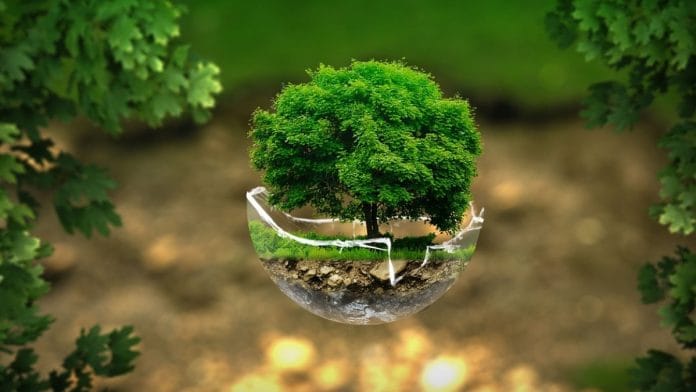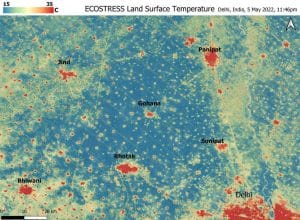
Thank you dear subscribers, we are overwhelmed with your response.
Your Turn is a unique section from ThePrint featuring points of view from its subscribers. If you are a subscriber, have a point of view, please send it to us. If not, do subscribe here: https://theprint.in/subscribe/
Cities are experiencing the consequences of climate change and temperatures are breaking
records as heatwaves and heat domes scorch them. Asphalt roads, concrete buildings, narrow lanes, closely spaced structures, fossil fuel burning vehicles, and loss of greenery have turned our cities into Urban Heat Islands (UHI). By 2030, billions of city dwellers are expected to be frequently exposed to extreme heat stress. Let’s make our cities cool.
Albedo effect
Solar radiation reaching the earth’s surface comprises of about 50% infra-red (heat), 45% visible light, and 5% UV (sun burn). It is well known that black and dark colours absorb more heat than white and lighter shades. Traditional roofing materials absorb 85% to 95% of the radiation. Conventional road and pavement materials like asphalt and concrete can reach 50⁰C to 70⁰C in summer.
Local bodies, builders, architects, housing societies, individual homeowners, paint, and paving manufacturers should be encouraged to adopt thermal reflectance and thermal emittance of materials as important design parameters for roofs, sun-facing exteriors walls, roads, and pavements.
Gas
LPG/LNG are fossil fuels. Whether we burn these in our power plants, vehicles, or in our cooking stoves, they will emit carbon dioxide, carbon monoxide, nitrogen dioxide, particulates, methane, and waste heat. About 60% of the energy in the gas fed to a stove gets wasted, much of it in heating the surroundings.
In comparison induction stoves have a thermal efficiency of over 80%.
The buildings being built now will last for several decades. Let us not lock them into fossil-fuel burning today. Henceforth all new residential buildings should be designed and built with all-electric kitchens.
Trees and vegetation
It is said, the best time to plant a tree was thirty years ago. The second-best time is now. All existing vegetation should be treated with reverence. Cities should make it very difficult to chop existing trees without very compelling reasons. Also, they should take up planting native, drought-resistant shade trees, and cover all open areas with plants, shrubs, and grass.
Shade from the leaves and branches allows only about 10% to 30% of solar radiation to reach the ground. The remainder is used for photosynthesis, absorbed by the plants, or reflected. Plants also absorb water from the ground and exhale it from the leaves. This transpiration cools the air by using heat from the air to evaporate water.

Shade
Shade trees can be planted along footpaths, streets, medians of major roads, around parking lots, school grounds, playgrounds. Creepers on walls and green roofs are other options.
Shading can also be achieved by permanent and movable shading structures, and proper orientation of buildings.
Rooftop Solar panels
Wherever technically feasible, housing roofs should be fitted with grid-connected solar panels. Large roofing in industries, godowns, parking lots, railway stations, stadiums, walkways, should be incentivized to adopt PV with storage.
Electric Vehicles
Conventional internal combustion (IC) engine vehicles convert 12% to 30% of the energy in the fuel petrol/diesel/gas to energy at the wheel. The rest of the energy is wasted with the exhaust gases and as heat. EVs convert nearly 80% of the supplied electric energy into power at the wheels.
By 2030 we should require 100% of all intra-city buses, goods transportation, and taxis, to be EV.
Air Conditioners
The mere thought of a power blackout during a heatwave will make us sweat. More than 20% of the electricity used on cities is on cooling. While ACs bring short-term relief, ACs are one of the biggest consumers of electric power and emitters of heat.it is not a feasible long-term solution on a warming planet. The increase in air conditioning, brings with it a huge demand for electricity. This demand drives climate change and even higher temperatures. To cut down on both, we should consider requiring AC manufacturers and sellers to limit minimum AC temperature settings to around 22⁰C- 24⁰C.
Alleviating UHI should be a major aspect of any new development project. Cities around the world are also taking measures to tackle UHI. We can learn from their experiences.
● Darwin, Australia – Shade structures; Cool pavements; Tree planting
● Chinese cities – Mist spraying at bus stops; green walls; water absorbing pavements, etc.
● Medellin, Colombia – Green Corridors project
● New York City, USA – Ban on gas stoves & gas heating in new constructions; Cool roofs program.
● Singapore – District level cooling; Green walls Project; Cooling Singapore project
● Vienna – Cool streets in summer (fountains, water spray and mist stations)
These pieces are being published as they have been received – they have not been edited/fact-checked by ThePrint.


COMMENTS